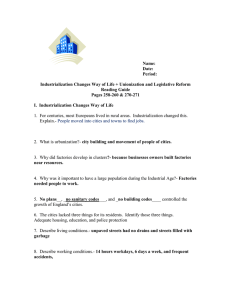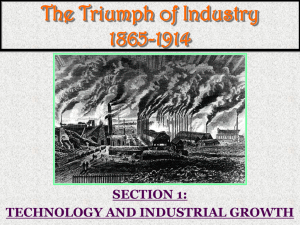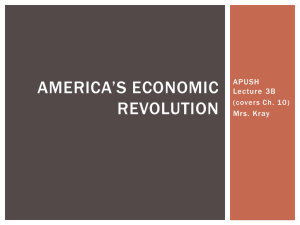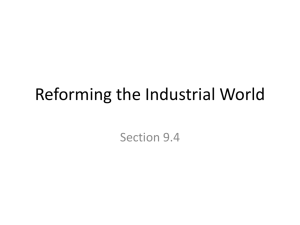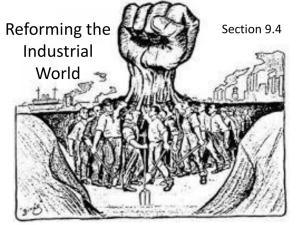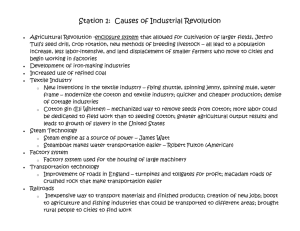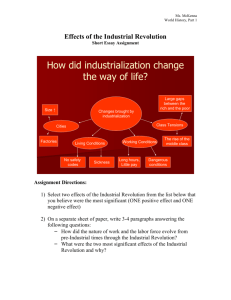25.3.4 PPT - Lyndhurst School District
advertisement
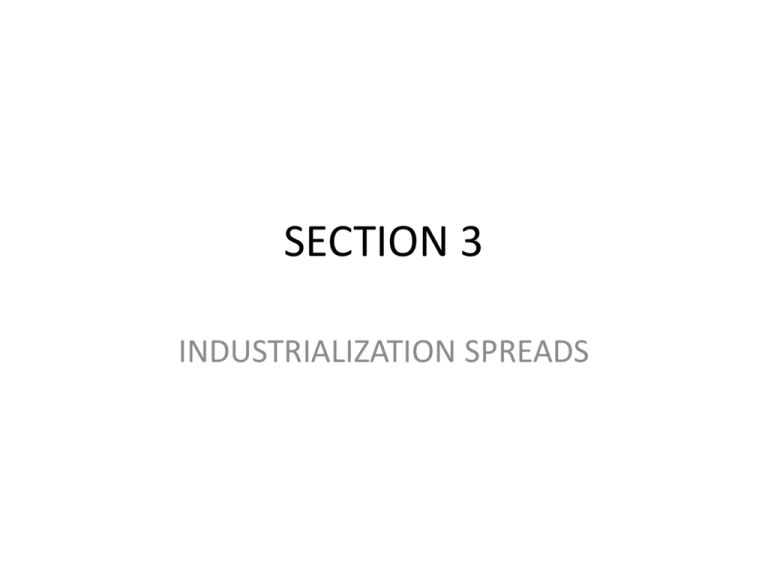
SECTION 3 INDUSTRIALIZATION SPREADS Industrial Development in the United States • Textile industry was the start • Samuel Slater emigrated to U.S and built spinning machine from memory in 1789 • Moses Brown opened first factory in Pawtucket, Rhode Island – Produced only one part of finished cloth-the thread and was shipped back to England – Brown is the Co-founder of Brown University • 1813- Francis Cabot Lowell- mechanized every stage in manufacture cloth. The town he opened his factory in, renamed it after him, Lowell, Massachusetts. • Single women flocked to become “mill girls” in factory towns. In these early towns, these women found higher wages and independence. • Shoemaking and clothing also underwent mechanization in the US. • Agricultural • U.S. remained primarily agricultural until Civil War ended in 1865. • Technological Boom • Beginning in the late 1800’s: – Wealthy natural resources (oil, coal, iron) – Burst of inventions (electric light bulb, telephone) – Increase in urban population that consumed new manufactured goods. • Railroads grow the US • Stocks Grow US Business • Cities like Chicago & Minneapolis expanded rapidly because of the RR’s • Certain rights of ownership of a company to raise money • Business owned by • Corporations become stockholders who share in the leaders of American its profits but are not Businesses personally responsible for its debts. Big Business • Standard Oil (John D. Rockefeller) & US Steel Company (Andrew Carnegie) sought to control every aspect of their own industries in order to make big profits. Continental Europe Industrializes • Belgium • Adopted Britain’s new technology. Rich deposits of iron ore, coal, and waterways. • William Cockerill carried secret plans for building spinning machinery. Son built enormous industrial enterprise which included steam engines & railway locomotives • Germany • Around 1835, German states began to copy the British model of factories. • However, each state separately created their own factory/ transportation systems • Built railroads that linked its manufacturing cities with coal & iron ore deposits. • The United German economic strength enabled military to grow into a giant through industry. • Bohemia- spinning industry • Spain’s Cataloniaprocessed more cotton than Belgium • Northern Italymechanized its textile production, specializing in silk. • Moscow & St. Petersburg- Serf labor factories • France- Agricultural economy remained strong. – Avoided great social & economic problems until 1850 when industrialization really started to move in forward in France • Other countries did not industrialize because of transportation problems. The Impact of Industrialization 1. Industrialization Revolution shifted the world balance of power in favor of Europe and the US 2. The wealth gap between industrialized and nonindustrialized countries grew incredibly. 3. Industrialized countries looked at nonindustrialized countries for steady supply of materials for food and raw materials 4. An Age of Imperialism would begin- policy of extending one country’s rule over many other lands, gave even more power and wealth to these already wealthy nations. 5. Industrialization created the need and want for Imperialism because the need for resources to supply the factories was a national priority for European Countries and the US SECTION 4 REFORMING THE INDUSTRIAL WORLD The Philosophers of Industrialization • Industrial Nations followed the theory of “Laissez Faire” which meant letting owners of industry and business set working conditions without interference. Free market unregulated by government • Governments placed heavy tariffs, in order to make tax revenue, on foreign goods that cut of free trade and held back the economy. • Adam Smith • Professor at University of Glasgow, Scotland. • Defended free economy market. • Believed in three natural laws: 1. Law of Self-Interest People work for their own good 2. Law of Competition Competition forces better products 3. Law of Supply and Demand People work for their own good • Smith’s Free Market • An economic system in Ideas are not practical, which the factors of so his beliefs are used in production are privately the economic system of owned and money is Capitalism invested in business ventures to make profit. The Rise of Socialism • Utilitarianism • A belief system of Jeremy Bentham • Believed people should judge ideas, institutions, and actions on the basis of their utility or usefulness. • John Stuart Mill- a philosopher and economist, led the utilitarian movement. Mill wished to help ordinary working people with equal division of profit. • Favored cooperative system of agriculture, women’s rights, right to vote. • Also pushed for reforms in the legal and prison system and in education. • Robert Owen • From Scotland, he built houses which he rented for low rates. • He prohibited children under ten working in the mills and provided free schooling for them. • In 1824, traveled to New Harmony, Indiana. And founded a cooperative community and intended it to be call his “Utopia”. Only lasted 3 years. • Socialism • New economic system which develops where the factors of production are owned by the public and operate for welfare of all. • Grew out of an optimistic view of human nature, belief in progress, and concern for social justice • This system government should plan the economy rather than depend on free market capitalism. • Socialists want the government to control factories, mines, railroads, and other key industries that would promote equality and end poverty for everyone • Public ownership would help workers. Marxism: Radical Socialism • Karl Marx- German journalist. Believed capitalist system would destroy itself. • Factories drive out small artisans. • Large proletariat (workers) would revolt, seize the factories and mills then produce what society needed. • Workers would share in profits, bring economic equality for all people, would control government but would wither away as a classless society developed. • Marx final phase was Communism. • A form of complete socialism which the means of production- all land, mines, factories, railroads, and businesses- would be owned by the people. • Private property would not exist. • All good and services would be shared equally. • The Communist Manifesto was published in 1848 by Karl Marx and Friedrich Engels on their ideas. • In the 1900’s Marxism inspired revolutionaries such as Russia’s VI Lenin, China’s Mao Zedong, and Cuba’s Fidel Castro. Labor Unions and Reform Laws • Unions- workers joined together in voluntary labor associations to be united for better working conditions & higher pay. • Collective Bargaining- negotiations between workers in unions and their employers • Strike- workers refuse to work • Skilled workers led the way forming unions Unions Gain Power • British government repealed the Combination Acts of 1799 & 1800 in 1824 that allowed unions and strikes. • In U.S. the American Foundation of Labor (AFL) formed in 1886 that won members higher wages and shorter hours. • Child Labor reform came when Parliament passes Factory Act of 1833. This made it illegal to hire children under 9. Children 9-12 wouldn’t work more than 8 hours a day. Children 13-17 only 12 hours a day. • Mines Act in 1842- prohibited children & women from working underground. Unions Gain Power • Hours Act of 1847- Limited workday to ten hours for women and children who worked in factories. • National Child Labor Committee in U.S. set up in 1904 to end child labor. • However, in 1919, U.S. Supreme Court objected that the federal child labor law as it interfered with states’ rights to regulate The Reform and Movement Spreads • Abolition of Slavery- William Wilberforce fought to end slavery and Britain abolished slavery throughout the empire in 1833. – However Britain would have plenty of labors to take advantage of throughout the world • • • • Slavery ended in U.S. in 1865 after Civil War Puerto Rico in 1873 Cuba in 1886 (controlled by Spain) Brazil in 1888 Women’s Rights • Women received higher wages working in factories than at home but still only a third (1/3) of what men were paid. • Movement for women’s rights began in the United States in 1848 at the Seneca Falls Convention in New York. The International Council for Women formed in 1888. Reforms Spread to Many Areas of Life • Public Education & Prison reform were seen as needed changes in the U.S. and Western Europe • Free public school system began in the 1850’s. • Reform prisons emphasized the goal of providing prisoners with the means to lead to useful lives upon release.
